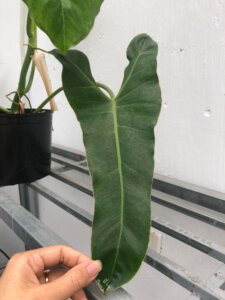Basic Information
Philodendron Paraiso Verde is a tropical plant famous for its vibrant variegation and climbing nature. Its leaves are long, deeply lobed, and green with irregular yellow and light green markings. This philodendron thrives in warm, humid, well-drained soil and bright, indirect light. It grows rapidly and requires a moss pole or other support to climb. This plant can be an excellent addition to your indoor garden with proper care and conditions.
The color of plant leaves can be affected by factors such as temperature, light, and humidity. For example, in the picture, the leaves on the right are grown in warm temperatures, while the ones on the left grow in cold winters. Both leaves are from the same Philodendron Paraiso plant that I grew myself. So, if you want your plant to have vibrant and colorful leaves, it is important to pay attention to temperature and light conditions. By carrying out timely interventions, you can maintain the perfect brightness and color of the leaves.


Light
The Philodendron Paraiso Verde plant thrives in bright but indirect sunlight. It’s important to keep it away from direct sun exposure, as it can damage the leaves. The plant’s variegation may turn green if it doesn’t get enough light. A balance between shade and light is necessary, as too much shade can slow its growth. The best place to put it would be near east-facing windows or in a spot with filtered light.
Water
This particular plant thrives when it’s watered on a consistent schedule, allowing the top half of the soil to dry out before each watering. You can insert a finger or use a moisture meter to check the soil moisture. Over-watering should be avoided as it can cause root rot, a common problem in this species, which brown, mushy roots and a foul smell can identify. Rainwater or filtered water is the best option for watering, but tap water can also be used.
Soil
For the Paraiso Verde plant, it is best to use light soil that drains well and is rich in organic matter. The soil should be kept moist but not waterlogged to prevent root rot. Adding perlite and peat moss can help maintain the right moisture level. Aiming for a mildly acidic soil pH between 5.0 and 6.0 is recommended.
Temperature
Paraiso Verde thrives best in a warm environment with temperatures ranging from 65° to 85° F (18° to 29° C). It’s a sensitive plant and doesn’t do well in cold drafts or sudden temperature changes. Therefore, keeping it away from air conditioning vents or drafty windows is crucial.
Humidity
This tropical plant thrives in highly humid environments, preferably around 65% or higher. In case you live in an area with less humid conditions, you can increase the humidity by using a humidifier, placing the plant on a pebble tray, or grouping it with other plants to create a microclimate. However, be careful with misting as it can lead to fungal infections due to constantly wet leaves.
Fertilizer
Fertilize every 4-6 weeks during the growing season (spring and summer) with a balanced fertilizer. Reduce fertilization frequency in winter. Philodendron Paraiso Verde isn’t a heavy feeder, but regular feeding promotes robust growth.
Growth Rate
Paraiso Verde grows relatively quickly in optimal conditions, particularly during late spring through early fall. Growth slows in winter, and factors like light, water, and humidity significantly influence its growth rate.
Pet Safety
Due to calcium oxalate crystals, Philodendron Paraiso Verde is toxic to pets and humans. Symptoms of ingestion include irritation of the mouth and GI tract. Keep it out of reach of pets and children.
Grow in Semi-Hydro
- Philodendrons, celebrated for their lush foliage and adaptability, thrive in semi-hydroponic systems such as LECA/Pon, thanks to their resilient root systems and preference for consistent moisture.
- Shifting a Philodendron to a semi-hydroponic setting works well using a Nutrient Stagnant Wicking (NSW) method, providing a stable and effective environment for growth.
- Within the LECA/Pon environment, Philodendron roots adapt swiftly, effectively managing any early challenges in adapting to the NSW system.
- For nourishing Philodendrons in semi-hydro systems, a nutrient solution with a concentration around 800-1000ppm is optimal.
- Philodendrons are versatile in adapting to a range of temperature and humidity levels, making them ideal for various indoor settings.
- Regular care involves monitoring the reservoir’s water level and periodically flushing the system to ensure the Philodendron’s healthy and consistent growth.
- If your Philodendron is a climber, it’s a must to look at our Moss Pole guide to have a proper set-up.
Tips
- Repotting: Repot only when root-bound, using a container 1-2 inches larger in diameter.
- Pruning: Prune dead or yellowing leaves to maintain health and appearance.
- Propagation: Use stem cuttings for propagation, ideally in spring or summer.
- Pest Management: Look out for aphids and spider mites. Treat with neem oil or insecticidal soap.
- Support: Provide a moss pole or trellis for climbing.
Philodendron Paraiso Verde is an attractive and easy-to-care-for plant that can add a tropical touch to any space. Despite having some drawbacks, its gorgeous appearance and minimal maintenance requirements make it a popular choice among plant enthusiasts. This article will serve as a guide to assist you in successfully growing and caring for your Philodendron Paraiso Verde.
Happy planting! 🌱


